Finding More than Waldo: Template Matching Adventures
In a world brimming with images, we're about to embark on a captivating journey: a digital treasure hunt reminiscent of finding Waldo in a bustling scene. Template matching, the art of uncovering hidden patterns, becomes our compass in this adventure.
Imagine peering into a chaotic scene, hunting for Waldo's iconic stripes – a task akin to the essence of template matching. Together, we'll demystify this technique, delving into its inner workings where math and algorithms team up to decode visual enigmas. With every line of code, we channel the fervor of a "Waldo seeker," resolute in discovering the unexpected. Our template matching expedition mirrors exploration, revealing hidden universes beneath pixel layers. Just as finding Waldo surpasses a game, our quest transcends surfaces, unveiling a web of unseen connections.
So, fellow adventurers, get ready. As we delve into template matching, pixels become puzzle pieces, code opens doors, and the realm of hidden tales within images awaits our exploration. Let the quest commence.
Embarking on the Quest:
Picture yourself in a vibrant beach scene – a whirlwind of colors, shapes, and characters. Amidst this lively chaos, your mission is clear: locate Waldo. You immerse yourself in the image, scanning every nook and cranny, finding exhilaration in each discovery, no matter how small.
This is the heart of template matching – a digital expedition where we become explorers and detectives, unraveling image patterns that elude the casual eye. Just as spotting Waldo transforms a bustling scene into an enigma, template matching reveals the hidden tales within pixels.
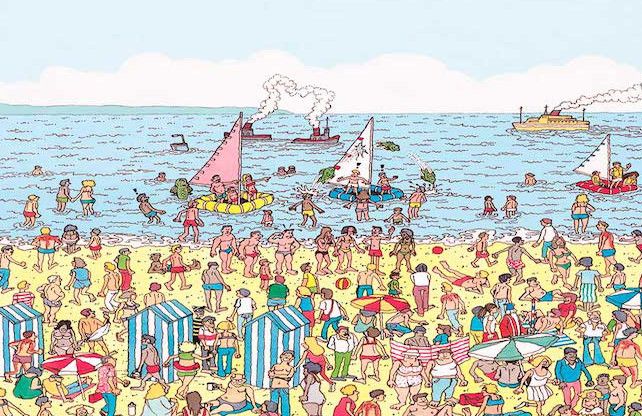
As our journey delves deeper, we're captivated by the unexpected. Both in Waldo hunting and template matching, allure lies in uncovering layers beneath the surface, decoding visual stories concealed in plain sight.
Every image becomes a canvas of clues, a landscape to explore. Just as a seasoned Waldo hunter spots telltale signs, template matching equips us with algorithms to navigate the intricate image tapestry.
With each pattern revealed, we decipher design intricacies, color harmonies, and shape symphonies. Images cease to be just visuals; they become portals to uncharted realms where discovery awaits at every turn.
So, intrepid adventurers, as we embark on this template matching journey, embrace curiosity. Let the parallels between Waldo hunts and hidden pattern quests ignite your excitement. Pixel treasures await – are you ready to unveil their secrets?
Unveiling the Template Matching Mechanism:
In the realm of image analysis, where pixels hold untold stories, template matching emerges as a powerful technique, akin to the systematic search for Waldo in a bustling scene. Just as our eyes scrutinize every detail to spot the iconic striped shirt, template matching scans images pixel by pixel to unearth hidden patterns, revealing the intricate web of connections woven within.
At its core, template matching hinges on the principle of comparison. Imagine you're equipped with a magnifying glass, examining the beach scene closely to identify Waldo. Similarly, template matching employs a template, a small image patch representing the pattern you seek, to scan a larger image in search of instances that closely resemble the template.
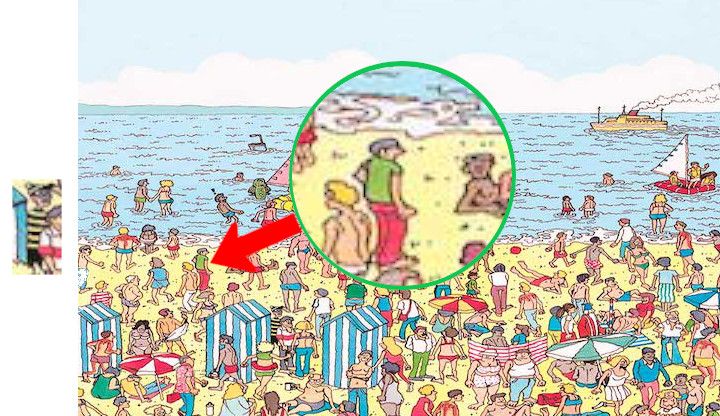
But how does the algorithm determine the likeness between the template and the image fragments it encounters? The answer lies in mathematical operations and similarity scoring. Think of it as assigning a score to each image fragment based on how closely it aligns with the template. This scoring mechanism, often involving techniques like normalized cross-correlation, quantifies the degree of resemblance and guides us to potential matches.
Consider the template as your guiding star, leading you through the image wilderness. Just as you meticulously compare each face in the crowd to the mental image of Waldo, template matching measures the correlation between the template and various portions of the image, highlighting regions that share visual traits.
As your search for Waldo is marked by excitement with each new discovery, template matching keeps a vigilant watch over image fragments, alerting us to instances where patterns align, often unveiling subtle relationships that the naked eye might overlook.
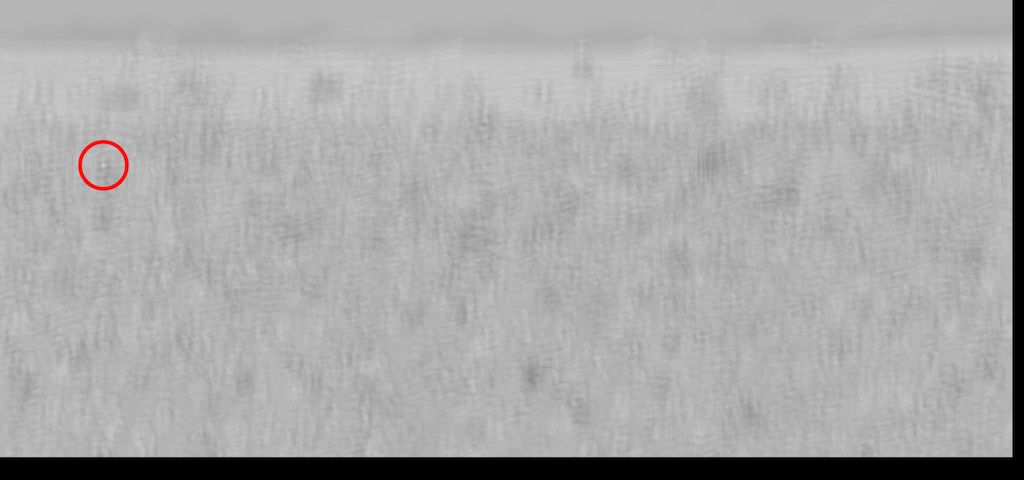
With template matching, we're not merely searching; we're decoding the language of images. We're translating patterns into numerical scores, deciphering the symphony of shapes and hues that compose every visual composition. Our digital magnifying glass, powered by algorithms and mathematical precision, guides us through the intricate terrain, connecting the dots and revealing the stories that images whisper.
Behind the Scenes of Detection
In the heart of template matching lies a world of algorithms and computations, where the art of observation converges with the precision of mathematics. Just as a master Waldo seeker deciphers subtle clues in illustrations, template matching algorithms meticulously analyze images to uncover the concealed patterns that lie beneath the surface.
Imagine you're in a puzzle-solving competition, sifting through a collection of intricate drawings in search of Waldo. You're not merely scanning; you're decoding the visual landscape, identifying distinctive elements that mark Waldo's presence. Template matching mirrors this process, breaking down images into a language of mathematical symbols and similarity scores.

At its essence, template matching is a digital detective. The algorithm ventures through the image, comparing the template's features with various fragments, each a potential piece of the puzzle. Just as a clue might point you towards a specific section of an illustration, the algorithm identifies regions where patterns align, signaling a potential match.
One of the tools in the template matching detective's toolkit is normalized cross-correlation. Think of it as a measure of how closely two patterns align – a higher score indicating a stronger resemblance. This correlation score guides the algorithm's steps, leading it through the image as if following a trail of breadcrumbs.
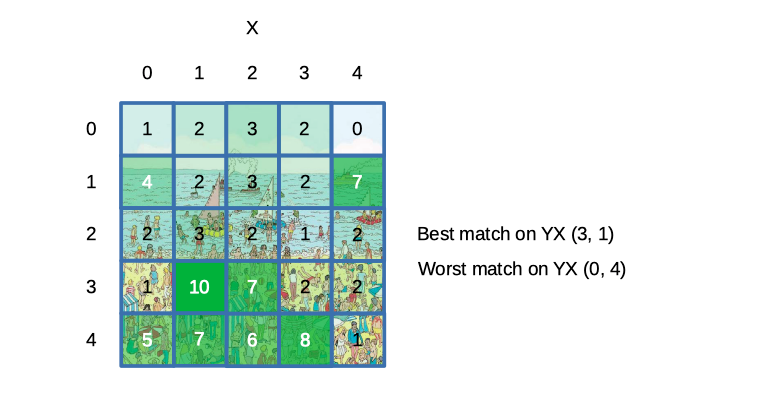
Consider the complexity of deciphering Waldo's location amidst a sea of visual elements. It requires a trained eye to recognize patterns, colors, and shapes that subtly differ from their surroundings. In template matching, the algorithm is equipped with a similar discernment, evaluating each fragment's similarity to the template and identifying the regions that stand out.
Much like a skilled Waldo seeker learns to distinguish unique details – a telltale hat, a distinct walking stick – template matching algorithms identify key features within the template and seek corresponding characteristics in the image. This intricate dance between template and image, guided by numerical comparisons, transforms the chaos of pixels into a choreographed symphony of patterns.
Applications: Beyond the Hunt for Waldo:
While the quest for Waldo captivates our imagination, the power of template matching extends far beyond the realm of striped shirts and crowded scenes. Like a versatile tool in the hands of a skilled craftsman, template matching finds its place in a multitude of real-world applications, each unveiling its own hidden gems.
1. Medical Imaging Precision: In the realm of medicine, template matching transforms into a life-saving instrument. Imagine a physician searching for anomalies within a medical scan – just as a Waldo seeker scours an illustration. Template matching aids in the precise identification of patterns, aiding doctors in spotting tumors, fractures, and other critical details that may otherwise go unnoticed.
2. Quality Control and Manufacturing: Industries rely on template matching to ensure products meet rigorous standards. It's like a digital inspector examining each item on a production line. From verifying the alignment of components to identifying defects, template matching plays a crucial role in maintaining quality and efficiency.
3. Object Recognition and Tracking: Template matching acts as a digital tracker, detecting and following objects in dynamic environments. Imagine the template as a signature that identifies a specific object. Just as a Waldo seeker recognizes familiar features, template matching algorithms can distinguish and track moving objects in surveillance, robotics, and autonomous vehicles.
4. Image Registration and Alignment: In the world of photography and remote sensing, template matching aligns images taken from different perspectives or at different times. It's like matching puzzle pieces from different boxes. By pinpointing common features, template matching enables accurate image registration and creates seamless composite images.
5. Character and Handwriting Recognition: Template matching steps into the shoes of a linguist, deciphering characters and words. Just as a Waldo seeker identifies distinct elements, template matching algorithms recognize patterns in handwriting and characters, enabling efficient optical character recognition (OCR) systems.
6. Biometric Identification: Imagine template matching as a digital fingerprint examiner. In biometrics, it plays a vital role in facial recognition, matching unique features to establish identity. Just as a Waldo seeker confirms a match based on characteristic details, template matching verifies individuals through facial or iris patterns.


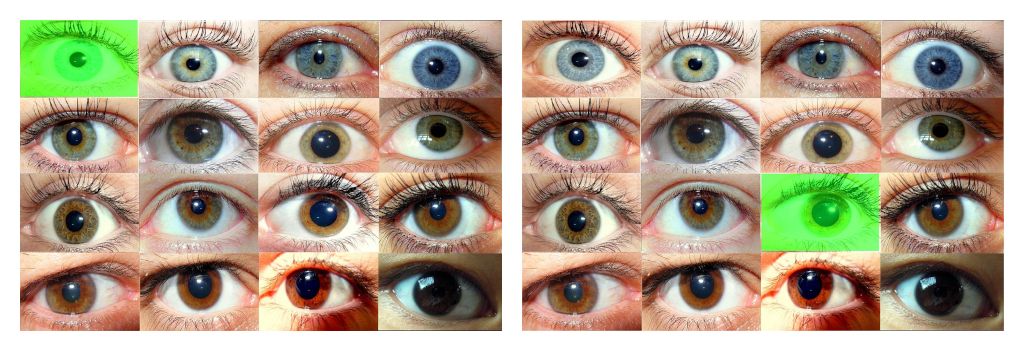
7. Archaeology and Art Restoration: Template matching becomes an art restorer, piecing together fragments of history. In archaeology, it assists in reconstructing artifacts from broken pieces, much like identifying Waldo through scattered details. Additionally, it aids in the analysis and restoration of ancient artwork.
Challenges in Image Pattern Detection
Embarking on the template matching journey is like venturing into a vast world of images, each holding its own secrets. Just as explorers adapt to changing terrains, we too must overcome challenges in this ever-evolving image landscape.
- Changing Lights: Imagine hunting for Waldo as daylight fades. Like this, template matching faces lighting variations that distort patterns. Innovations in preprocessing and adaptive algorithms help algorithms detect patterns accurately in different lighting conditions.
- Scale and Perspective: Picture Waldo shifting in size and angle. In template matching, changes in scale and perspective can complicate pattern detection. Techniques like scale-invariant matching allow the algorithm to spot patterns regardless of size or angle.
- Rotations and Transformations: Consider Waldo turning around, making him unrecognizable. Similarly, images may undergo rotations or transformations that hide patterns. Template matching tackles this through methods like rotation-invariant matching, even in distorted images.
- Noise and Distortions: Imagine spotting Waldo in a crowded scene. Like this, image noise and distortions can hinder template matching. Techniques for noise reduction and feature-based methods enhance meaningful pattern extraction.
- Multi-Scale Exploration: Just as you explore different parts of an illustration, template matching analyzes images at various scales, detecting patterns of different sizes.
Advancements in Template Matching
In the world of image analysis, the quest for patterns and connections never rests. Just as Waldo seekers refine their techniques over time, the realm of template matching experiences a continuous wave of innovation that reshapes the way we perceive and interact with images.
- Learning from Data: Like Waldo seekers who improve with experience, template matching algorithms learn from diverse datasets. Deep neural networks revolutionize pattern recognition, enhancing accuracy and complexity. They adapt to patterns, becoming more precise and versatile.
- Focusing on Features: Just as Waldo seekers notice unique details, template matching uses feature-based methods to identify key elements in patterns.
- Considering Context: Similar to seeking Waldo within a scene, template matching algorithms analyze surroundings for better accuracy.
- Adapting to Changes: Template matching handles transformations by using techniques like elastic matching and shape context.
- Speeding Up with GPUs: Just as tools aid Waldo seekers, template matching employs GPU acceleration for faster, efficient analysis.
Template Matching in Action: Code Showcase.
Get ready to immerse yourself in the world of template matching with a hands-on code demonstration. In this section, we'll delve into the C++ code that brings the concept to life, bridging the gap between theory and practical implementation.
Understanding the Template: Our exploration begins by establishing the template – the distinctive pattern we aim to uncover within an image. Just as a dedicated Waldo seeker identifies key features, we'll use fundamental C++ functions to load and preprocess the template image.
struct Match {
int r = -1, c = -1;
double correlation = numeric_limits<double>::min();
};
Pixel calculateCorrelation(
Pixel &imgsProduct, Pixel &imgSum, Pixel &tempSum,
int templateHeight, int templateWidth
) {
Pixel imgSum2 = imgSum * imgSum;
Pixel tempSum2 = tempSum * tempSum;
double WxH = templateWidth * templateHeight;
Pixel numerator = imgsProduct - (imgSum * tempSum) / (WxH);
Pixel denominator = ((imgSum2 - (tempSum2 * WxH)) * (tempSum2 - (tempSum2 * WxH))).sqrt();
return numerator / denominator;
}
Match: We've crafted a structured container named "Match" to encapsulate essential information about a potential match. This includes the row "r," column "c," and the calculated correlation "correlation" score. Initial values are thoughtfully set to signify the absence of a match (-1 for "r" and "c," and an exceedingly low value for "correlation").
calculateCorrelation: This function plays a pivotal role in evaluating the correlation between pixel data. It accepts three Pixel objects – "imgsProduct," "imgSum," and "tempSum" – along with the dimensions of the template. By employing a specialized formula, it computes the correlation score for a given pixel. This involves calculating squared sums and then determining the correlation by dividing a numerator by the square root of the product of two denominators.
double calculatePixelCorrelation(Image &img, Image &tempImg, int r, int c) {
Pixel imgSum = { 0.0, 0.0, 0.0 };
Pixel tempSum = { 0.0, 0.0, 0.0 };
Pixel imgsProduct = { 0.0, 0.0, 0.0 };
for (int rr = 0; rr < tempImg.height; ++rr) {
for (int cc = 0; cc < tempImg.width; ++cc) {
Pixel pixImg = img.at(r + rr, c + cc);
Pixel pixTemp = tempImg.at(rr, cc);
// Calculate correlation using RGB channels
imgSum += (pixImg * pixImg);
tempSum += (pixTemp * pixTemp);
imgsProduct += (pixImg * pixTemp);
}
}
auto cor = calculateCorrelation(imgsProduct, imgSum, tempSum, tempImg.height, tempImg.width);
return cor.avg();
}calculatePixelCorrelation: Dive deeper into the pixel-level correlation assessment between the main image ("img") and the template ("tempImg") at a specific position (row "r" and column "c"). The function meticulously accumulates squared color channel sums for both the image and the template. Subsequently, it leverages the "calculateCorrelation" function to ascertain the correlation score. An assumed "avg()" function computes the average value of the Pixel channels, contributing to the overall correlation score.
Match findInImage(Image &img, Image &tempImg, string resultPath) {
Match bestMatch;
double bestMatchScore = 0.0;
Image correlationImg(img.height, img.width, 3);
for (int r = 0; r <= img.height - tempImg.height; ++r) {
for (int c = 0; c <= img.width - tempImg.width; ++c) {
double correlation = calculatePixelCorrelation(img, tempImg, r, c);
correlationImg.at(r, c) = { (float)correlation, (float)correlation, (float)correlation };
if (correlation > bestMatch.correlation) {
bestMatch.c = c;
bestMatch.r = r;
bestMatch.correlation = correlation;
}
}
}
printf("Best match found at (%d, %d) correlation %.20f\n", bestMatch.r, bestMatch.c, bestMatchScore);
return bestMatch;
}findInImage Function: Serving as the crux of the operation, this function embarks on a quest to locate the best match between the main image and the template. It commences by initializing a "Match" struct named "bestMatch" to effectively track the most promising match identified so far. The function navigates through the main image using nested loops, meticulously assessing each possible position for the template. For each position, it employs the "calculatePixelCorrelation" function to compute the correlation score and updates the "bestMatch" details whenever a higher correlation is detected. Upon completion, the function presents insightful information about the best match and returns the "bestMatch" struct for further analysis.
Conclusion: Embracing the Adventure:
Our expedition through the realm of template matching has revealed a captivating synergy between art and science. As we navigated the intricate landscape of C++ code, we unveiled the essence of correlation assessment – a process akin to unraveling hidden patterns in a crowded visual tapestry. Just as dedicated Waldo seekers discern subtle details, we've harnessed the power of algorithms to extract meaningful insights from images. While this chapter may conclude, the adventure persists. Armed with the tools of template matching, you're poised to unlock a world of applications and innovations, where each line of code becomes a thread in the fabric of discovery. The journey beckons, inviting you to illuminate the unseen, decode intricate narratives, and embark on a perpetual quest for visual revelation.
